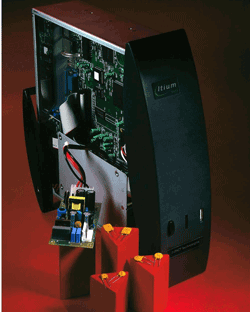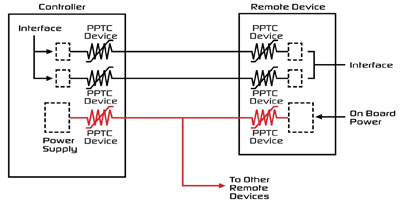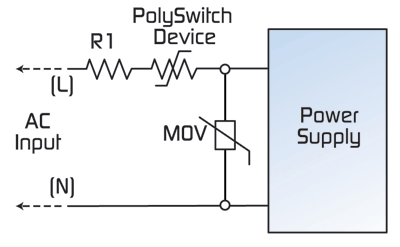Coordinated circuit protection for industrial controllers, power supplies, and portable equipment
Coordinated overvoltage/overcurrent circuit protection can help designers reduce component count
BY BARRY BRENTS and MATT WILLIAMS
Tyco Electronics’ Circuit Protection Business Unit
Menlo Park, CA
http://www.raychem.tycoelectronics.com
Protecting an electronic circuit from damage due to excessive current or heat is the primary function of many circuit protection technologies. In the past, this protection took the form of a fuse or fusible link. In many of today’s applications, resettable polymeric positive temperature coefficient (PPTC) devices are the preferred solution.

A coordinated circuit protection scheme using PPTC overcurrent devices and MOV (metal oxide varistor) or MLV (multilayer varistor) overvoltage devices can help protect equipment such as industrial controllers and switch-mode power supplies (SMPSs) from damage caused by excessive currents during a fault or overload condition, as well as voltage transients or exposure to steady-state overvoltage conditions. Additionally, a polymer-enhanced zener diode can help protect portable equipment from damage caused by both overcurrent and overvoltage transients.
Industrial controller protection
Traditionally, single-use fuses have been used to protect electronic circuits from damage caused by overcurrent events. With this approach, the fuse blows when a wiring fault or part failure creates a condition in which excessive currents can flow, thereby breaking the electrical connection and helping prevent more widespread damage or fire hazards.
The problem with this technology is that a failure in one system component can disable other components downstream and throughout the system. When this happens, the fuse must be accessed and replaced on all the affected components before the system can be made operational again. In contrast, resettable fault protection can help minimize the impact that failure has on the system, reduce the number of system components affected, and shorten repair time.
In many industrial controller applications, replacing single-use fuses with PPTC devices allows designers to maintain the same level of overcurrent protection on the critical interfaces, while generally eliminating the need for fuse replacement or service when an external fault condition results in transient high-current conditions in the system.
The PPTC device has a low-resistance value under normal operating currents. In the event of an overcurrent event, the device “trips” into a high-resistance state. This increased resistance helps protect the equipment in the circuit by reducing the amount of current that can flow under the fault condition to a low, steady-state level. The device remains in its latched position until the fault is cleared. Once power to the circuit is cycled, the PPTC device resets, allowing current flow to resume and restoring the circuit to normal operation.
As seen in Fig. 1 , in addition to controllers, any remote sensor, indicator or actuator that requires a power, analog or communications bus interface can benefit from the use of PPTC circuit protection. These system components may be subject to damage caused by miswiring, power cross, or loose neutral connections on ac mains inputs.

Fig. 1. PPTC devices help protect the interfaces between controllers and remote devices as well as power inputs.
Power supply protection
Switch-mode power supplies offer the size, weight, and energy-saving advantages required for consumer electronics and have continued to replace linear-regulators in many applications. However, because SMPSs lack the inherent resistance of prior generation designs, they often require more robust circuit protection.
PPTC overcurrent protection devices can help manufacturers meet UL60950-1/LPS (Limited Power Source) requirements for SMPSs and improve equipment safety and reliability. While these devices cannot prevent a fault from occurring, they respond quickly, limiting current to a safe level to help prevent collateral damage to downstream components. Additionally, the small form factor of PPTC devices makes them easy to use in space-constrained applications.
As shown in Fig. 2 , a PolySwitch PPTC device can be installed in series with the power input to help protect against damage resulting from electrical shorts, overloaded circuits or customer misuse. Additionally, an MOV placed across the input helps provide overvoltage protection.
The PolySwitch device may also be placed after the MOV. Many equipment manufacturers prefer protection circuits combining resettable PPTC devices with upstream fail-safe protection. In this example, R1 is a ballast resistor used in combination with the protection circuit.

Fig. 2. Typical circuit protection design for switch-mode power supplies.
Transient protection for portable equipment
The mobile functionality of portable media players (PMPs), navigation devices, smart phones, play stations and other battery-powered portable equipment offers consumers an increasingly connected lifestyle between their home, office, and vehicle. However, every time these products are connected or disconnected, they may be exposed to circuit damage caused by user error, wrong supply voltages, or voltage or current transients.
Transient protection is critical when designing peripherals that may be powered off computer buses and automotive power buses. On computer buses, inductively generated voltage spikes can exceed 8 V on the 5-V line and 16 V on the 12-V line, which can cause damage to unprotected peripherals.
Traditional clamping diodes represent the simplest circuit protection solution for portable electronics. However, in order to withstand the potential power output of a non-approved charger while still providing resettable protection, this diode must be capable of dissipating nearly all of the power that a nonapproved charger could deliver. The resultant protection solution would therefore require both a large diode and significant heat-sinking infrastructure.
The latest generation of clamping diodes, Tyco Electronics’ PolyZen device, offers designers the simplicity of a traditional clamping diode while obviating the need for significant heat sinking. This single-device solution helps protect against damage resulting from the use of improper power supplies. It also helps provide transient suppression, reverse bias protection, and protection from damage caused by overcurrent events.
As shown in Fig. 3 , the PolyZen micro-assembly incorporates a stable zener diode for crisp voltage clamping and a resistively non-linear PPTC layer, which responds to either diode heating or overcurrent events by transitioning from a low- to a high-resistance state. In the event of a sustained high-power overvoltage condition, the tripped PPTC element limits current and generates a voltage drop to help protect both the zener and the follow-on electronics — effectively increasing the diode’s power-handling capability.

Fig. 3. Tyco Electronics’ PolyZen device helps provide input power protection for portable electronics.
The PolyZen device is particularly effective at clamping and smoothing inductive voltage spikes. In response to an inductive spike the zener diode element shunts current to ground until the voltage is reduced to the normal operating range. In the case of a wrong voltage power supply, the device clamps the voltage, shunts excess power to ground, and eventually locks out the wrong supply. The relatively flat voltage versus current response of the device helps clamp the output voltage, even when input voltage and source currents vary.
Coordinated overvoltage/overcurrent circuit protection can help designers reduce component count, provide a safe and reliable product, comply with regulatory agency requirements, and reduce warranty and repair costs. ■
Advertisement
Learn more about TE Connectivity





